SELENITE APPARATUS SUPPLIED WITH A ROSS BAR LIMB COMPOUND MICROSCOPE
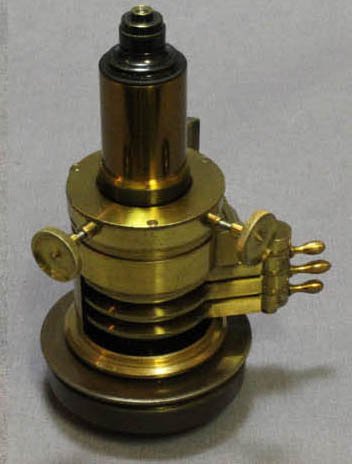
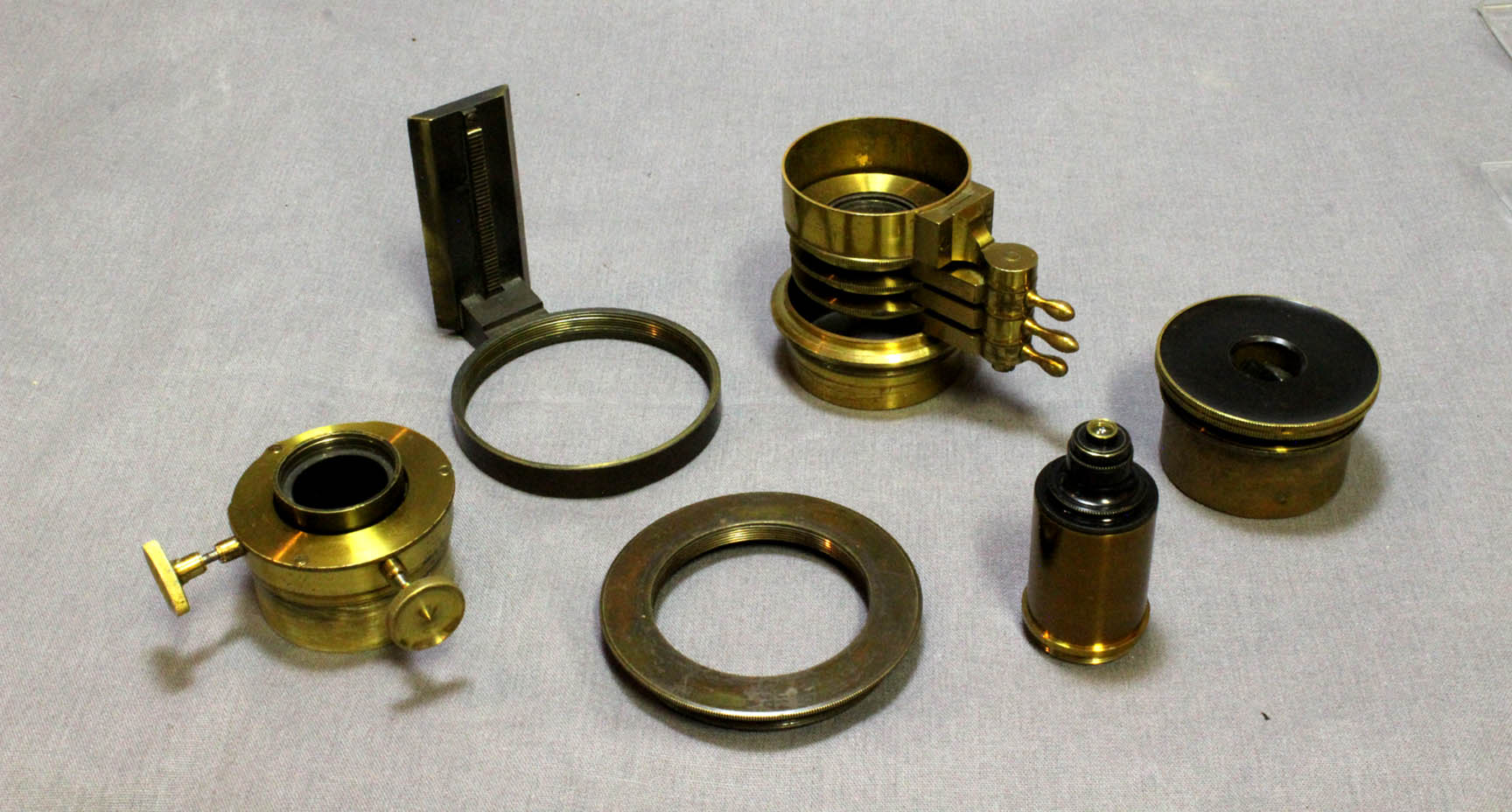
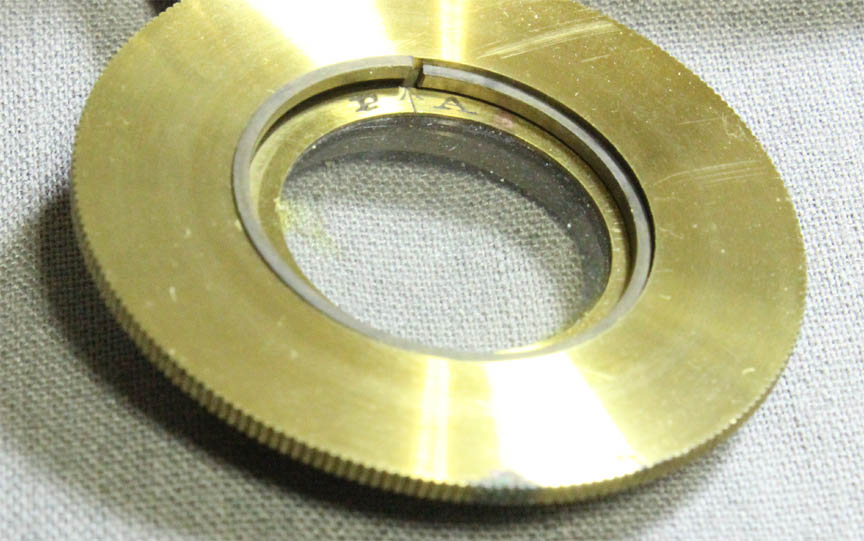 An 1847 Andrew Ross Bar Limb microscope in my collection has a set of accessories designed to illustrate the properties of polarized light and also observe anisotropic subjects. The substage apparatus containing the three stacked rotatable selenites(retarders), has little levers so each of the three selenites can be swung in or out of the optical axis at will. Each rotating selenite, is marked on their inner ring with 'P | A' for the direction of the positive axis.
An 1847 Andrew Ross Bar Limb microscope in my collection has a set of accessories designed to illustrate the properties of polarized light and also observe anisotropic subjects. The substage apparatus containing the three stacked rotatable selenites(retarders), has little levers so each of the three selenites can be swung in or out of the optical axis at will. Each rotating selenite, is marked on their inner ring with 'P | A' for the direction of the positive axis.
They are also individually labeled, presumably with their degree of retardation 180 degrees from the positive axis mark, presumably with their degree of retardation, but not the same as the other later examples seen below.  The top selenite is labeled on on underside, while the middle and bottom selenite are labeled on the top side. The writing is partially obscured by the overlap of the outer ring and the writing is very difficult to read in any case. It appears each selenite is labeled with the standard wavelengths of ' 9/4,3/4, and 1/4'. These labels are all on the inner selenite rings which ride inside the outer lacquered brass rings; this makes the retardation labels, especially the fractions, extremely difficult to make out even with magnification, as they are partially obscured by the outer brass rings and there are many minute scratches partially obscuring them as well. The entire set of selenites slides on and off of the brass support by a small dovetail. This is required, as the levers for the selenites protrude preventing turning of the housing required for its installation into the substage ring. The support of the stacked selenite apparatus is threaded near its lower end to screw into the shorter of the two smaller diameter fittings for the main substage ring. When installed, it allows its bottom to protrude and accept the large polarizer which slides into its bottom under the support; the top accepts the centering device, thus allowing the use of a condenser with the polarization apparatus. The purpose of using a condenser with this apparatus is to intensify the image especially when using high power.
The top selenite is labeled on on underside, while the middle and bottom selenite are labeled on the top side. The writing is partially obscured by the overlap of the outer ring and the writing is very difficult to read in any case. It appears each selenite is labeled with the standard wavelengths of ' 9/4,3/4, and 1/4'. These labels are all on the inner selenite rings which ride inside the outer lacquered brass rings; this makes the retardation labels, especially the fractions, extremely difficult to make out even with magnification, as they are partially obscured by the outer brass rings and there are many minute scratches partially obscuring them as well. The entire set of selenites slides on and off of the brass support by a small dovetail. This is required, as the levers for the selenites protrude preventing turning of the housing required for its installation into the substage ring. The support of the stacked selenite apparatus is threaded near its lower end to screw into the shorter of the two smaller diameter fittings for the main substage ring. When installed, it allows its bottom to protrude and accept the large polarizer which slides into its bottom under the support; the top accepts the centering device, thus allowing the use of a condenser with the polarization apparatus. The purpose of using a condenser with this apparatus is to intensify the image especially when using high power.
Below is an image to illustrate the multiple assembly steps required for the substage polarization apparatus. The substage for this microscope is threaded to accept the insert of smaller diameter threads. The first image shows the substage ring and the insert. The second image shows the insert screwed in. Once this is installed, the housing for the selenites can be screwed on to it. The selenites themselves, attached to that housing by a dovetail, must be removed until the housing has been screwed on because the housing would not be able to fully rotate with the selenites installed. The next images show how the centering apparatus slides into the top of the selenite housing. The achromatic objective can then be screwed on to the top of the centering apparatus. Finally, the polarizer is pushed into the selenite housing from the bottom as its black and knurled rotating side is of larger diameter than the threaded insert. One can see why, within a few years, this method of attachment to the substage was abandoned in favor of a much easier to use system, in which the selenite assembly simply slid into a sleeve with its own centering controls.

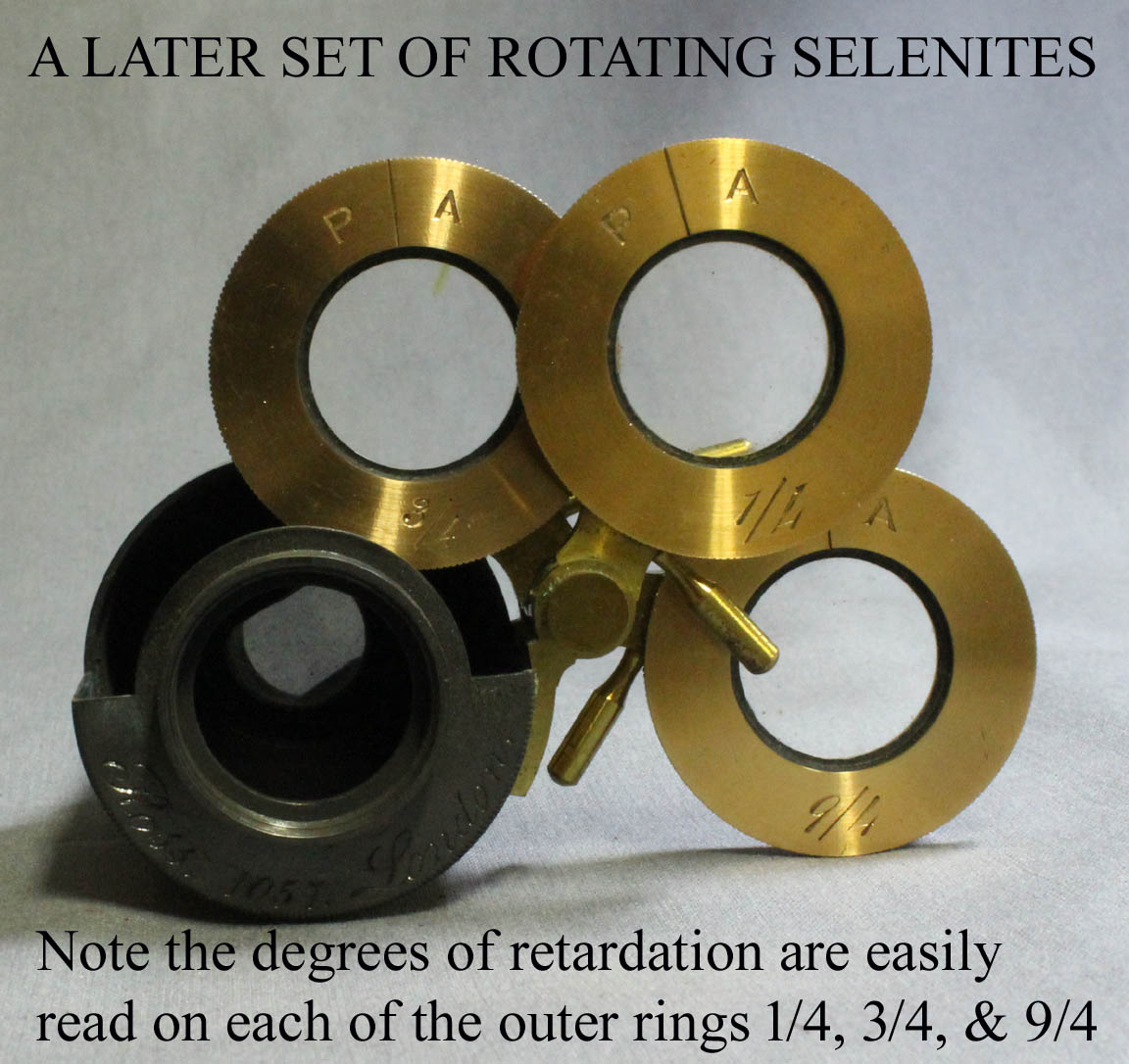
The stacking selenite apparatus, listed as being 'in an improved setting' in 1872, was not listed in the 1862 or earlier Ross catalogs, illustrating that it was possibly an accessory that was added later than the time this microscope was originally constructed. A very similar apparatus is llustrated in Richard Beck's book of 1865(see below).
In both of the newer examples, the labeling is on the outer rings and is much clearer and easier to read. But on these, the fractions of wavelength retardation are each different and include ¼, ¾ and 9/4. As the 1872 Ross catalog states, by varying the number of selenites used, and changing their rotation, 13 different colors can be produced. This is because the wavelength of the retardation can be varied. If the positive axis of one selenite is lined up with that of another they are additive. If one is 90 degrees from the other, they oppose each other. For example if the ¾ and ¼ are lined up the total is 1. If they are at right angles the total is ½.
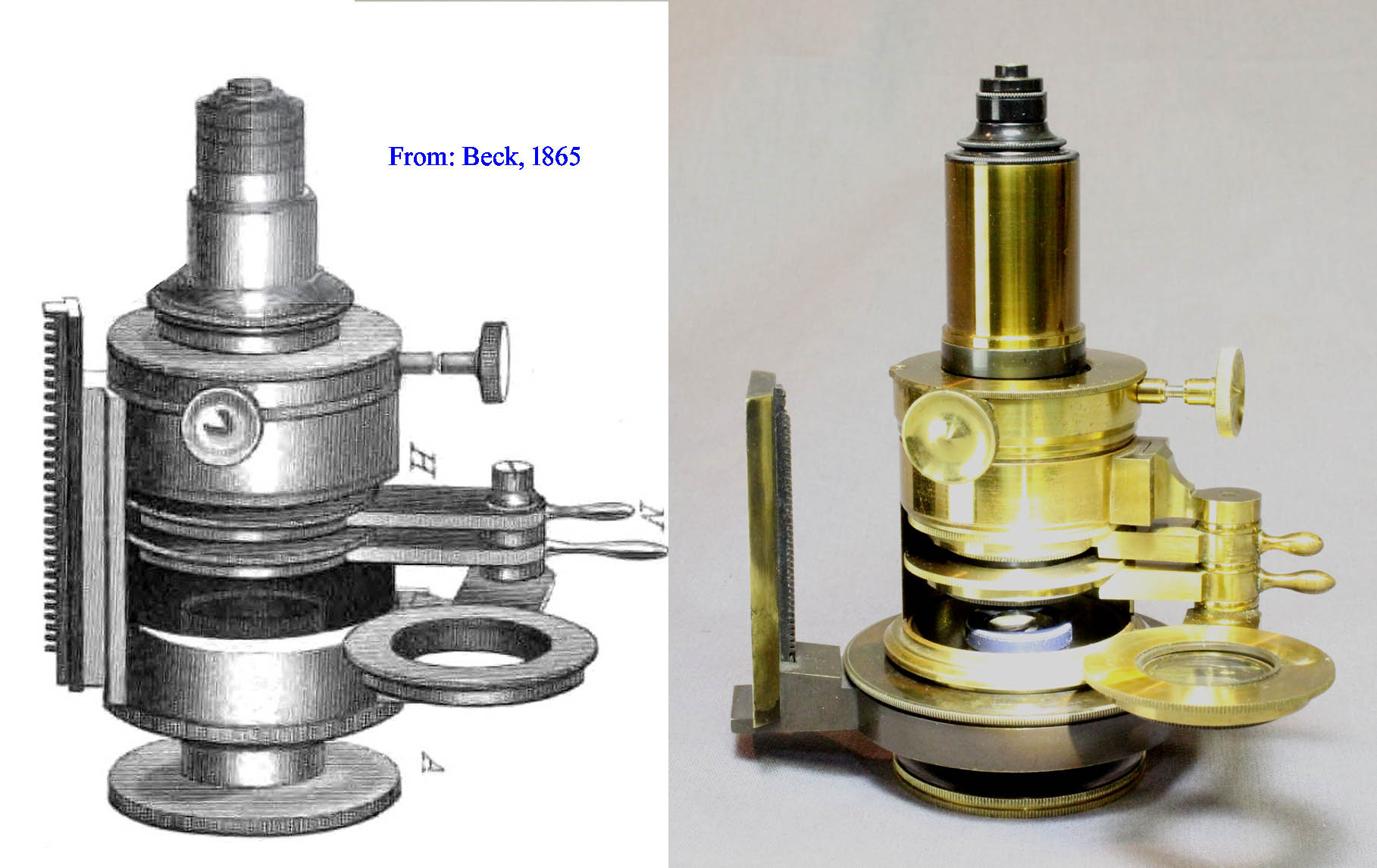 Interestingly, as can be seen in the image to the left, a very similar substage polarizing apparatus including centering apparatus, polarizer, and stack of selenites, topped off with an achromatic condenser, is pictured in Richard Beck's book of 1865 entitled Treatise on the Construction, Proper Use and Capabilities of Smith, Beck and Beck's Achromatic microscopes. To this author, this suggests that, at least in the beginning, one manufactory was making this apparatus for both firms; since Ross later signed and serial numbered them, it is possible Ross was the original maker of these, but as yet I have no proof of that. It is very feasible that William H. Darker, the inventor of this stacked selenite apparatus, supplied the selenites themselves.
Interestingly, as can be seen in the image to the left, a very similar substage polarizing apparatus including centering apparatus, polarizer, and stack of selenites, topped off with an achromatic condenser, is pictured in Richard Beck's book of 1865 entitled Treatise on the Construction, Proper Use and Capabilities of Smith, Beck and Beck's Achromatic microscopes. To this author, this suggests that, at least in the beginning, one manufactory was making this apparatus for both firms; since Ross later signed and serial numbered them, it is possible Ross was the original maker of these, but as yet I have no proof of that. It is very feasible that William H. Darker, the inventor of this stacked selenite apparatus, supplied the selenites themselves.
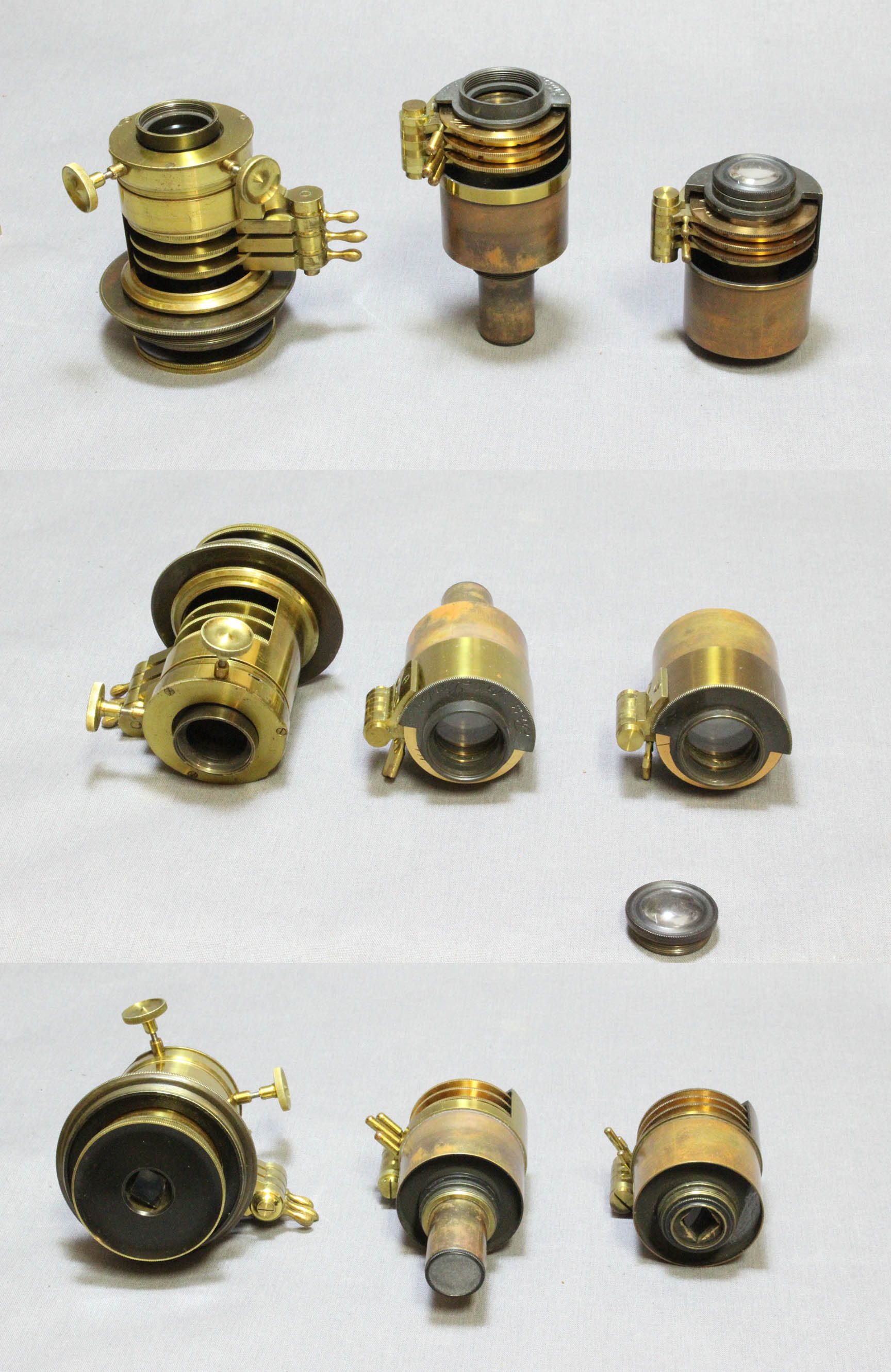 As time went on, the design of this apparatus was changed to suit the newer design of the Ross substage condenser arrangement. In the later versions the centering apparatus was now integrated into the main substage support ring, so that all accessories fit into it. In these versions, the stacked selenite apparatus simply had a thread on top to accept a condenser, as the entire assembly could then be centered at once. The thread on the newer stack of selenites is the RMS standard for objectives(which were often used as condensers), not the thread found with this early Ross instrument, which fits only the early purpose-made condensers. The condensers found with the Ross Bar Limb No 324, will not fit the top of the newer versions of the stack of selenites. Shown to the left are comparisons of three examples of the rotating stack of selenites. To the left is the early form found with the Ross No 324. This early form is shown with the centering apparatus on top. The other two examples have no provision for this as they would fit into the substage which already had provision for centering. The middle one has a thread on top for a condenser, and a thread on the bottom to accept a polarizer. The one on the right has polarizer permanently attached inside its bottom. The one on the right has a small lens which can be used on top as a condenser or alternatively, it will accept an objective as a condenser just like the middle example. Also note the improvement in labeling; although the early model has the selenites labeled only on the inside black rings, the later two examples have much larger and easier to read labeling on the outer lacquered brass ring. The early example and the one to the right are unsigned, but the middle example is signed 'Ross. 1057. London'. Early on, Ross supplied high power objectives to Smith and Beck, so it is possible Ross also supplied these selenite fixtures to Beck in the 1860's. The selenite filters were often referred to as 'Darker's Selenites'. At least early on, the selenites themselves were likely supplied from the great William H. Darker himself.
As time went on, the design of this apparatus was changed to suit the newer design of the Ross substage condenser arrangement. In the later versions the centering apparatus was now integrated into the main substage support ring, so that all accessories fit into it. In these versions, the stacked selenite apparatus simply had a thread on top to accept a condenser, as the entire assembly could then be centered at once. The thread on the newer stack of selenites is the RMS standard for objectives(which were often used as condensers), not the thread found with this early Ross instrument, which fits only the early purpose-made condensers. The condensers found with the Ross Bar Limb No 324, will not fit the top of the newer versions of the stack of selenites. Shown to the left are comparisons of three examples of the rotating stack of selenites. To the left is the early form found with the Ross No 324. This early form is shown with the centering apparatus on top. The other two examples have no provision for this as they would fit into the substage which already had provision for centering. The middle one has a thread on top for a condenser, and a thread on the bottom to accept a polarizer. The one on the right has polarizer permanently attached inside its bottom. The one on the right has a small lens which can be used on top as a condenser or alternatively, it will accept an objective as a condenser just like the middle example. Also note the improvement in labeling; although the early model has the selenites labeled only on the inside black rings, the later two examples have much larger and easier to read labeling on the outer lacquered brass ring. The early example and the one to the right are unsigned, but the middle example is signed 'Ross. 1057. London'. Early on, Ross supplied high power objectives to Smith and Beck, so it is possible Ross also supplied these selenite fixtures to Beck in the 1860's. The selenite filters were often referred to as 'Darker's Selenites'. At least early on, the selenites themselves were likely supplied from the great William H. Darker himself.
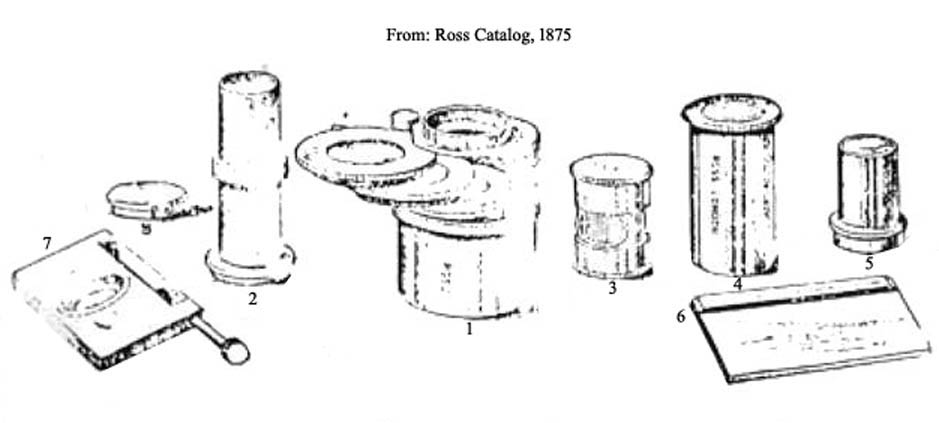 The 1875 Ross catalog entry for the stacking selenite apparatus is actually the later version with the threaded top.
The 1875 Ross catalog entry for the stacking selenite apparatus is actually the later version with the threaded top.
The author is indebted to Paul Ferraglio for help in deciphering the selenite labels of Ross No. 324.


 An 1847 Andrew Ross Bar Limb microscope in my collection has a set of accessories designed to illustrate the properties of polarized light and also observe anisotropic subjects. The substage apparatus containing the three stacked rotatable selenites(retarders), has little levers so each of the three selenites can be swung in or out of the optical axis at will. Each rotating selenite, is marked on their inner ring with 'P | A' for the direction of the positive axis.
An 1847 Andrew Ross Bar Limb microscope in my collection has a set of accessories designed to illustrate the properties of polarized light and also observe anisotropic subjects. The substage apparatus containing the three stacked rotatable selenites(retarders), has little levers so each of the three selenites can be swung in or out of the optical axis at will. Each rotating selenite, is marked on their inner ring with 'P | A' for the direction of the positive axis. The top selenite is labeled on on underside, while the middle and bottom selenite are labeled on the top side. The writing is partially obscured by the overlap of the outer ring and the writing is very difficult to read in any case. It appears each selenite is labeled with the standard wavelengths of ' 9/4,3/4, and 1/4'. These labels are all on the inner selenite rings which ride inside the outer lacquered brass rings; this makes the retardation labels, especially the fractions, extremely difficult to make out even with magnification, as they are partially obscured by the outer brass rings and there are many minute scratches partially obscuring them as well. The entire set of selenites slides on and off of the brass support by a small dovetail. This is required, as the levers for the selenites protrude preventing turning of the housing required for its installation into the substage ring. The support of the stacked selenite apparatus is threaded near its lower end to screw into the shorter of the two smaller diameter fittings for the main substage ring. When installed, it allows its bottom to protrude and accept the large polarizer which slides into its bottom under the support; the top accepts the centering device, thus allowing the use of a condenser with the polarization apparatus. The purpose of using a condenser with this apparatus is to intensify the image especially when using high power.
The top selenite is labeled on on underside, while the middle and bottom selenite are labeled on the top side. The writing is partially obscured by the overlap of the outer ring and the writing is very difficult to read in any case. It appears each selenite is labeled with the standard wavelengths of ' 9/4,3/4, and 1/4'. These labels are all on the inner selenite rings which ride inside the outer lacquered brass rings; this makes the retardation labels, especially the fractions, extremely difficult to make out even with magnification, as they are partially obscured by the outer brass rings and there are many minute scratches partially obscuring them as well. The entire set of selenites slides on and off of the brass support by a small dovetail. This is required, as the levers for the selenites protrude preventing turning of the housing required for its installation into the substage ring. The support of the stacked selenite apparatus is threaded near its lower end to screw into the shorter of the two smaller diameter fittings for the main substage ring. When installed, it allows its bottom to protrude and accept the large polarizer which slides into its bottom under the support; the top accepts the centering device, thus allowing the use of a condenser with the polarization apparatus. The purpose of using a condenser with this apparatus is to intensify the image especially when using high power.

 Interestingly, as can be seen in the image to the left, a very similar substage polarizing apparatus including centering apparatus, polarizer, and stack of selenites, topped off with an achromatic condenser, is pictured in Richard Beck's book of 1865 entitled Treatise on the Construction, Proper Use and Capabilities of Smith, Beck and Beck's Achromatic microscopes. To this author, this suggests that, at least in the beginning, one manufactory was making this apparatus for both firms; since Ross later signed and serial numbered them, it is possible Ross was the original maker of these, but as yet I have no proof of that. It is very feasible that William H. Darker, the inventor of this stacked selenite apparatus, supplied the selenites themselves.
Interestingly, as can be seen in the image to the left, a very similar substage polarizing apparatus including centering apparatus, polarizer, and stack of selenites, topped off with an achromatic condenser, is pictured in Richard Beck's book of 1865 entitled Treatise on the Construction, Proper Use and Capabilities of Smith, Beck and Beck's Achromatic microscopes. To this author, this suggests that, at least in the beginning, one manufactory was making this apparatus for both firms; since Ross later signed and serial numbered them, it is possible Ross was the original maker of these, but as yet I have no proof of that. It is very feasible that William H. Darker, the inventor of this stacked selenite apparatus, supplied the selenites themselves.  As time went on, the design of this apparatus was changed to suit the newer design of the Ross substage condenser arrangement. In the later versions the centering apparatus was now integrated into the main substage support ring, so that all accessories fit into it. In these versions, the stacked selenite apparatus simply had a thread on top to accept a condenser, as the entire assembly could then be centered at once. The thread on the newer stack of selenites is the RMS standard for objectives(which were often used as condensers), not the thread found with this early Ross instrument, which fits only the early purpose-made condensers. The condensers found with the Ross Bar Limb No 324, will not fit the top of the newer versions of the stack of selenites. Shown to the left are comparisons of three examples of the rotating stack of selenites. To the left is the early form found with the Ross No 324. This early form is shown with the centering apparatus on top. The other two examples have no provision for this as they would fit into the substage which already had provision for centering. The middle one has a thread on top for a condenser, and a thread on the bottom to accept a polarizer. The one on the right has polarizer permanently attached inside its bottom. The one on the right has a small lens which can be used on top as a condenser or alternatively, it will accept an objective as a condenser just like the middle example. Also note the improvement in labeling; although the early model has the selenites labeled only on the inside black rings, the later two examples have much larger and easier to read labeling on the outer lacquered brass ring. The early example and the one to the right are unsigned, but the middle example is signed 'Ross. 1057. London'. Early on, Ross supplied high power objectives to Smith and Beck, so it is possible Ross also supplied these selenite fixtures to Beck in the 1860's. The selenite filters were often referred to as 'Darker's Selenites'. At least early on, the selenites themselves were likely supplied from the great William H. Darker himself.
As time went on, the design of this apparatus was changed to suit the newer design of the Ross substage condenser arrangement. In the later versions the centering apparatus was now integrated into the main substage support ring, so that all accessories fit into it. In these versions, the stacked selenite apparatus simply had a thread on top to accept a condenser, as the entire assembly could then be centered at once. The thread on the newer stack of selenites is the RMS standard for objectives(which were often used as condensers), not the thread found with this early Ross instrument, which fits only the early purpose-made condensers. The condensers found with the Ross Bar Limb No 324, will not fit the top of the newer versions of the stack of selenites. Shown to the left are comparisons of three examples of the rotating stack of selenites. To the left is the early form found with the Ross No 324. This early form is shown with the centering apparatus on top. The other two examples have no provision for this as they would fit into the substage which already had provision for centering. The middle one has a thread on top for a condenser, and a thread on the bottom to accept a polarizer. The one on the right has polarizer permanently attached inside its bottom. The one on the right has a small lens which can be used on top as a condenser or alternatively, it will accept an objective as a condenser just like the middle example. Also note the improvement in labeling; although the early model has the selenites labeled only on the inside black rings, the later two examples have much larger and easier to read labeling on the outer lacquered brass ring. The early example and the one to the right are unsigned, but the middle example is signed 'Ross. 1057. London'. Early on, Ross supplied high power objectives to Smith and Beck, so it is possible Ross also supplied these selenite fixtures to Beck in the 1860's. The selenite filters were often referred to as 'Darker's Selenites'. At least early on, the selenites themselves were likely supplied from the great William H. Darker himself.  The 1875 Ross catalog entry for the stacking selenite apparatus is actually the later version with the threaded top.
The 1875 Ross catalog entry for the stacking selenite apparatus is actually the later version with the threaded top.